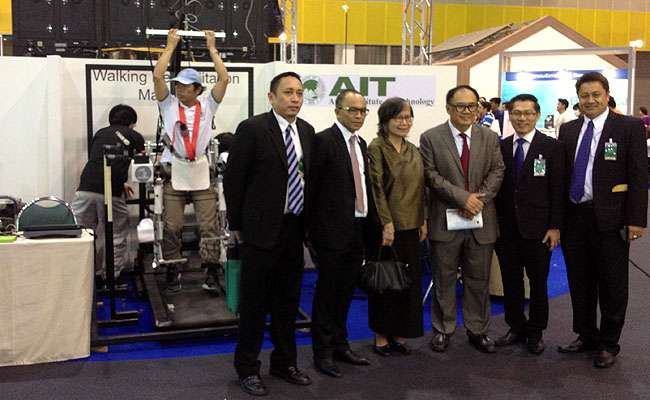The PM
studied and asked about the “Walking Rehabilitation Machine” and the
“Power Suit” developed by Mechatronics field of study Associate Prof.
Manukid Parnichkun and his engineering graduate
students.
AIT Vice President for Research Prof.
Kanchana Kanchanasut briefed Prime Minister Yingluck, who expressed
interest in the technology during her brief stop at the front of the
large AIT display.
Kanchana Kanchanasut briefed Prime Minister Yingluck, who expressed
interest in the technology during her brief stop at the front of the
large AIT display.
Noppadol Ajjanaromvat, 26, a third year
doctoral student, commented on the potential for the machine that
underpins his dissertation titled “Interactive Control of Legs
Exoskeleton.”
doctoral student, commented on the potential for the machine that
underpins his dissertation titled “Interactive Control of Legs
Exoskeleton.”
The Walking Rehabilitation Machine
consists of the robotic gait orthosis, a body weight support system and
a treadmill. The Thai graduate student sees it as having medical and
physiotherapy applications.
consists of the robotic gait orthosis, a body weight support system and
a treadmill. The Thai graduate student sees it as having medical and
physiotherapy applications.
“People with paralysis use it to try to
regain muscle structure in their legs,” he said. Patients can be
outfitted to address bad walking habits, and older persons can exercise
on the treadmill without fear of falling, he explained.
regain muscle structure in their legs,” he said. Patients can be
outfitted to address bad walking habits, and older persons can exercise
on the treadmill without fear of falling, he explained.
A patient’s legs are guided on the
treadmill according to a pre-programmed physiological gait pattern. The
computer controlled guidance allows individual adjustments of different
gait parameters.
treadmill according to a pre-programmed physiological gait pattern. The
computer controlled guidance allows individual adjustments of different
gait parameters.
Also displayed was the compelling bright
yellow ‘Power Suit Robot for Construction’, an exoskeleton robot
engineered to be worn by people to dramatically enhance strength. AIT
researchers see it benefiting construction workers and laborers who
might require extra strength for lifting heavy items.
yellow ‘Power Suit Robot for Construction’, an exoskeleton robot
engineered to be worn by people to dramatically enhance strength. AIT
researchers see it benefiting construction workers and laborers who
might require extra strength for lifting heavy items.
The steel and stainless steel suit
weighs about 41 kilograms. The robot can carry a payload up to 70
kilograms, said Rachan Chaihan, 24, a mechatronics Master’s student,
who was on hand to answer questions. Once fitted on to a person,
movement is controlled freely by the wearer through switches and
hydraulic actuators attached at shoulder joints and elbow joints of
each arm. Springs assist the wearer to stand straightly.
weighs about 41 kilograms. The robot can carry a payload up to 70
kilograms, said Rachan Chaihan, 24, a mechatronics Master’s student,
who was on hand to answer questions. Once fitted on to a person,
movement is controlled freely by the wearer through switches and
hydraulic actuators attached at shoulder joints and elbow joints of
each arm. Springs assist the wearer to stand straightly.
The lower extremity of the exoskeleton
uses springs attached to each joint of the leg to store potential
energy. In order to move the powersuit, the wearer must apply force to
the springs to the desired position, the engineers said.
uses springs attached to each joint of the leg to store potential
energy. In order to move the powersuit, the wearer must apply force to
the springs to the desired position, the engineers said.


